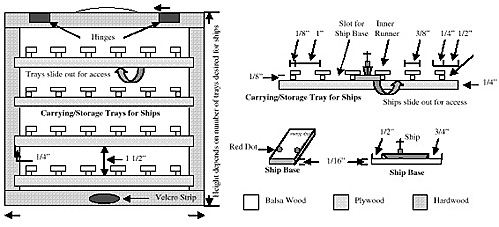Height depends on number of trays desired for ships.
As anyone who has ever wargamed with miniatures will attest, damage to one's miniatures is always a big concern. This can occur both while gaming and during transit. So the question was, how to safeguard my miniatures?
The first step was easy. Ships were mounted on a balsa wood base so players could handle the base and not the miniature. To keep things easy during the game, ship names were added on the top of the base at the back edge, behind the ship's stern. This allows players to readily identify which ships are theirs and which are targets. Painting a red dot on the base aligned with the ship's bridge lets players easily mark that point when measuring ranges
Building a traveling/storage case for my ships took a little more effort. The bases worked great, so what was needed was an easy way to transport the ships, prevent them from flipping over, and yet still see what ships I have. The first step was to build a tray with runners that kept the base trapped against the tray surface, but allowed the ship base to easily slide in and out. Balsa wood strips at your local hobby store work great for this. Measure the size of tray you want, based on the number of ships per tray you prefer.
Cut the 1/8" and 3/8" strips to run the length of the tray. First glue the 1/8" strip to the center of the 3/4" strip. Let dry. Mark your tray with 1" and 1/8" lines where the runners are to be placed. The lines should run the length of the tray and be bold enough so you can see them. These mark where the 1/8" strips go. Apply glue to the bottom of the 1/8" strip, turn over and place where the lines are marked on the tray. For the outer runners, use 1/4" strips as the cover strip instead.
For the case itself, I needed something that would prevent the trays from turning over and still allow easy access. The answer was a case that did the same thing for the trays that the trays did for the ships. The sides and back of the case are cut with a 1/4" deep groove that allows the trays to slide in and out, and yet keeps them in place when the front is closed. The grooves are cut to allow 1 1/2" between trays to allow for masts and radars. The front is a clear plexiglass cover, hinged at the top and held closed with a velcro strip at the bottom.

BT
Back to The Naval Sitrep #18 Table of Contents
Back to Naval Sitrep List of Issues
Back to MagWeb Master Magazine List
© Copyright 2000 by Larry Bond and Clash of Arms.
This article appears in MagWeb (Magazine Web) on the Internet World Wide Web.
Other military history articles and gaming articles are available at http://www.magweb.com